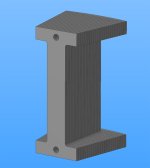rhitee05
10 kW
Okay, some updated results. The model I'm currently using has 2 mm thick N30SH magnets, 1 mm airgaps, and 18 turns on each core (2x9 turns). This works out to give a Kv of about 140 RPM/V. With 16 turns (2x8), it was around 160 RPM/V. This configuration gives a peak flux density of about 1.75-1.8 T in the cores. It would definitely be possible to achieve the same Kv of around 150 using fewer turns by increasing the flux, the only question is if saturation will come into play and limit the torque too much. For now this seems like a good working configuration.
I've decided that I need to take a step back and look more closely at how I'm calculating the torques. I'm still using the two different techniques and so far no matter what I've tried they don't agree with each other (right now, off by more than a factor of two), and neither agrees with the torque I expect from the Kt (one higher, one lower). That doesn't give me a warm fuzzy feeling. I'm going to take a little bit of time and try to find some good reference cases, where I can either calculate the forces myself by hand or have some experimental results to compare against.
I can also change the model to allow for 1 mm diameter holes in the cores, as shown below. I don't think it will affect things very much.
I've decided that I need to take a step back and look more closely at how I'm calculating the torques. I'm still using the two different techniques and so far no matter what I've tried they don't agree with each other (right now, off by more than a factor of two), and neither agrees with the torque I expect from the Kt (one higher, one lower). That doesn't give me a warm fuzzy feeling. I'm going to take a little bit of time and try to find some good reference cases, where I can either calculate the forces myself by hand or have some experimental results to compare against.
I can also change the model to allow for 1 mm diameter holes in the cores, as shown below. I don't think it will affect things very much.


